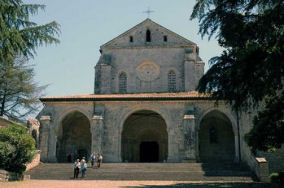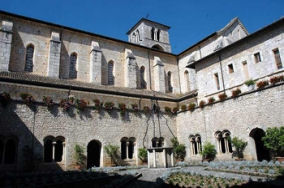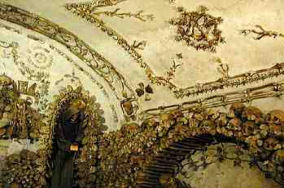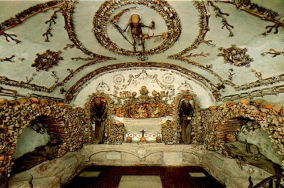|
|
|
|
| Roma • Viterbo |
|
||||||||||||||||
|
||||||||||||||||
|
|
||||
|
The present
building, Santa Maria Maggiore, near Rome's
Termini Station was built over the pagan temple of Cybele and
dates from the time of Pope Sixtus III in the fifth century. The
16th century ceiling was fashioned from a design by
Giuliano da Sangallo.
|
||||
|
|
||||
|
The Pantheon (Latin Pantheon), from Greek Πάνθειον Pantheon, meaning "Temple of all the gods") is a building in Rome which was originally built as a temple to all the gods of Ancient Rome, and rebuilt circa 125 CE during Hadrian's reign. The intended degree of inclusiveness of this dedication is debated. The generic term pantheon is now applied to a monument in which illustrious dead are buried.
It is the best preserved of all Roman buildings, and perhaps the best preserved building of its age in the world. It has been in continuous use throughout its history. The design of the extant building is sometimes credited to the Trajan's architect Apollodorus of Damascus, but it is equally likely that the building and the design should be credited to emperor Hadrian's architects, but not Hadrian himself as many art scholars once thought.
Since the 7th
century, the Pantheon has been used as a Catholic church. The
Pantheon is the oldest standing domed structure in Rome. The
height to the oculus and the diameter of the interior circle are
the same, 43.3 metres (142 ft). |
||||
 |
 |
|
Church facade at the Abbey of Casamari. |
Casamari's cloisters |
|
The
Abbazia di Casamari (Abbey of Casamari) is a 13th-century,
still-active Cistercian monastery southeast of Rome,
near Frosinone, in the Italian
region of Lazio.
|
 |
 |
|
Capuchin Crypt. left: A standing Capuchin monk skeleton surrounded by patterns made with bones. right:The Crypt of the Three Skeletons. Two small skeletons of children rest on the back wall,each holding a skull with wings made from shoulder blades. The third skeleton,impressed into the ceiling, is surrounded by a halo. It holds a scythe, the symbol of deathwhich cuts down all like grass in a field, and a pair of scales, representing God's judgment. |
|
|
If
you're a lover of the macabre... Rome has some fine skeletons for you.
Some are relics; others, sculptures.
*
Capuchin Church of the Immaculate Conception (1645), located on
Via Veneto, near Barbarini Square. Visit the crypt (there's a
small admission fee) to see the remains of mummified monks, the door is
manned by a Capuchin monk. The bones in this crypt were nailed to
the wall and arranged in patterns: cross, floral, arch, triangle and
circle, as well as forming objects. A large clock is composed of
vertebrae, foot bones and finger bones. The single hour hand represents
the idea that time has no beginning or end.
|
The Cathedral of
Viterbo was, according to legend, built on the site of an
Etruscan temple to Hercules and although
this can not be verified, Etruscan and Roman foundations can be seen
on several of the buildings which make up the Plaza di San Lorenzo
where the duomo is situated. An early medieval parish church
to Saint Lawrence had formerly occupied the area
before construction began on the cathedral in the late twelfth
century. Even as the duomo was constructed, the town was already
spreading northwards down the hill, leaving the plaza somewhat
isolated on the highest edges of town, thus restricting it’s
attraction to the townsfolk, a disadvantage which the local bishops
for years attempted to reverse by granting the cathedral special
religious privileges.
|
||||
| Artan Ramaj - Mobile: +39-32895 49342 Home: +39-055 576283 e-mail: info@privatetourdriveritaly.com |